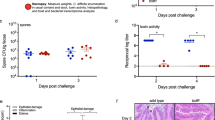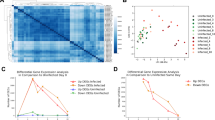Abstract
Clostridium difficile infection (CDI) is mediated by two major exotoxins, toxin A (TcdA) and toxin B (TcdB), that damage the colonic epithelial barrier and induce inflammatory responses. The function of the colonic vascular barrier during CDI has been relatively understudied. Here we report increased colonic vascular permeability in CDI mice and elevated vascular endothelial growth factor A (VEGF-A), which was induced in vivo by infection with TcdA- and/or TcdB-producing C. difficile strains but not with a TcdA−TcdB− isogenic mutant. TcdA or TcdB also induced the expression of VEGF-A in human colonic mucosal biopsies. Hypoxia-inducible factor signalling appeared to mediate toxin-induced VEGF production in colonocytes, which can further stimulate human intestinal microvascular endothelial cells. Both neutralization of VEGF-A and inhibition of its signalling pathway attenuated CDI in vivo. Compared to healthy controls, CDI patients had significantly higher serum VEGF-A that subsequently decreased after treatment. Our findings indicate critical roles for toxin-induced VEGF-A and colonic vascular permeability in CDI pathogenesis and may also point to the pathophysiological significance of the gut vascular barrier in response to virulence factors of enteric pathogens. As an alternative to pathogen-targeted therapy, this study may enable new host-directed therapeutic approaches for severe, refractory CDI.
This is a preview of subscription content, access via your institution
Access options
Access Nature and 54 other Nature Portfolio journals
Get Nature+, our best-value online-access subscription
$29.99 / 30 days
cancel any time
Subscribe to this journal
Receive 12 digital issues and online access to articles
$119.00 per year
only $9.92 per issue
Buy this article
- Purchase on Springer Link
- Instant access to full article PDF
Prices may be subject to local taxes which are calculated during checkout






Similar content being viewed by others
Data availability
All data reported in this study are available from the corresponding author on reasonable request.
References
Bartlett, J. G. Clostridium difficile: history of its role as an enteric pathogen and the current state of knowledge about the organism. Clin. Infect. Dis. 18, S265–S272 (1994).
Reineke, J. et al. Autocatalytic cleavage of Clostridium difficile toxin B. Nature 446, 415–419 (2007).
Torres, J., Jennische, E., Lange, S. & Lonnroth, I. Enterotoxins from Clostridium difficile; diarrhoeogenic potency and morphological effects in the rat intestine. Gut 31, 781–785 (1990).
Mitchell, T. J. et al. Effect of toxin A and B of Clostridium difficile on rabbit ileum and colon. Gut 27, 78–85 (1986).
Lyras, D. et al. Toxin B is essential for virulence of Clostridium difficile. Nature 458, 1176–1179 (2009).
Johal, S. S., Solomon, K., Dodson, S., Borriello, S. P. & Mahida, Y. R. Differential effects of varying concentrations of Clostridium difficile toxin A on epithelial barrier function and expression of cytokines. J. Infect. Dis. 189, 2110–2119 (2004).
Hecht, G., Koutsouris, A., Pothoulakis, C., LaMont, J. T. & Madara, J. L. Clostridium difficile toxin B disrupts the barrier function of T84 monolayers. Gastroenterology 102, 416–423 (1992).
Hecht, G., Pothoulakis, C., LaMont, J. T. & Madara, J. L. Clostridium difficile toxin A perturbs cytoskeletal structure and tight junction permeability of cultured human intestinal epithelial monolayers. J. Clin. Invest. 82, 1516–1524 (1988).
Pousa, I. D., Mate, J. & Gisbert, J. P. Angiogenesis in inflammatory bowel disease. Eur. J. Clin. Invest. 38, 73–81 (2008).
McLaren, W. J., Anikijenko, P., Thomas, S. G., Delaney, P. M. & King, R. G. In vivo detection of morphological and microvascular changes of the colon in association with colitis using fiberoptic confocal imaging (FOCI). Digest. Dis. Sci. 47, 2424–2433 (2002).
Danese, S. et al. Angiogenesis as a novel component of inflammatory bowel disease pathogenesis. Gastroenterology 130, 2060–2073 (2006).
Deban, L., Correale, C., Vetrano, S., Malesci, A. & Danese, S. Multiple pathogenic roles of microvasculature in inflammatory bowel disease: a Jack of all trades. Am. J. Pathol. 172, 1457–1466 (2008).
Danese, S. et al. Angiogenesis blockade as a new therapeutic approach to experimental colitis. Gut 56, 855–862 (2007).
Jerkic, M. et al. Dextran sulfate sodium leads to chronic colitis and pathological angiogenesis in Endoglin heterozygous mice. Inflamm. Bowel Dis. 16, 1859–1870 (2010).
Folkman, J. Angiogenesis: an organizing principle for drug discovery? Nat. Rev. Drug Discov. 6, 273–286 (2007).
Lin, C., McGough, R., Aswad, B., Block, J. A. & Terek, R. Hypoxia induces HIF-1α and VEGF expression in chondrosarcoma cells and chondrocytes. J. Orthop. Res. 22, 1175–1181 (2004).
Kroll, J. & Waltenberger, J. VEGF-A induces expression of eNOS and iNOS in endothelial cells via VEGF receptor-2 (KDR). Biochem. Biophys. Res. Commun. 252, 743–746 (1998).
Chidlow, J. H. et al. Differential angiogenic regulation of experimental colitis. Am. J. Pathol. 169, 2014–2030 (2006).
Bakirtzi, K. et al. The neurotensin-HIF-1α-VEGFα axis orchestrates hypoxia, colonic inflammation, and intestinal angiogenesis. Am. J. Pathol. 184, 3405–3414 (2014).
Warny, M. et al. p38 MAP kinase activation by Clostridium difficile toxin A mediates monocyte necrosis, IL-8 production, and enteritis. J. Clin. Invest. 105, 1147–1156 (2000).
Chen, X. et al. Saccharomyces boulardii inhibits ERK1/2 mitogen-activated protein kinase activation both in vitro and in vivo and protects against Clostridium difficile toxin A-induced enteritis. J. Biol. Chem. 281, 24449–24454 (2006).
Yu, H., et al. Cytokines are markers of the Clostridium difficile-induced inflammatory response and predict disease severity. Clin. Vaccine Immunol. 24, e00037-17 (2017).
Carter, G. P. et al. Defining the roles of TcdA and TcdB in localized gastrointestinal disease, systemic organ damage, and the host response during Clostridium difficile infections. mBio 6, e00551 (2015).
Duran, W. N., Breslin, J. W. & Sanchez, F. A. The NO cascade, eNOS location, and microvascular permeability. Cardiovasc. Res. 87, 254–261 (2010).
Ayrapetov, M. K. et al. Activation of Hif1α by the prolylhydroxylase inhibitor dimethyoxalyglycine decreases radiosensitivity. PLoS ONE 6, e26064 (2011).
Shah, Y. M., Matsubara, T., Ito, S., Yim, S. H. & Gonzalez, F. J. Intestinal hypoxia-inducible transcription factors are essential for iron absorption following iron deficiency. Cell Metab. 9, 152–164 (2009).
Holmes, K., Roberts, O. L., Thomas, A. M. & Cross, M. J. Vascular endothelial growth factor receptor-2: structure, function, intracellular signalling and therapeutic inhibition. Cell. Signal. 19, 2003–2012 (2007).
Scaldaferri, F. et al. VEGF-A links angiogenesis and inflammation in inflammatory bowel disease pathogenesis. Gastroenterology 136, 585–595 (2009).
Danese, S. Negative regulators of angiogenesis in inflammatory bowel disease: thrombospondin in the spotlight. Pathobiology 75, 22–24 (2008).
Kanazawa, S. et al. VEGF, basic-FGF, and TGF-β in Crohn’s disease and ulcerative colitis: a novel mechanism of chronic intestinal inflammation. Am. J. Gastroenterol. 96, 822–828 (2001).
Tsiolakidou, G., Koutroubakis, I. E., Tzardi, M. & Kouroumalis, E. A. Increased expression of VEGF and CD146 in patients with inflammatory bowel disease. Digest. Liver Dis. 40, 673–679 (2008).
Kapsoritakis, A. et al. Vascular endothelial growth factor in inflammatory bowel disease. Int. J. Colorectal Dis. 18, 418–422 (2003).
LaMont, J. T. & Kandel, G. P. Toxic megacolon in ulcerative colitis. Early diagnosis and management. Hosp. Pract. 21, 102–106 (1986).
Kurose, I. et al. Clostridium difficile toxin A-induced microvascular dysfunction. Role of histamine. J. Clin. Invest. 94, 1919–1926 (1994).
Hirota, S. A. et al. Hypoxia-inducible factor signaling provides protection in Clostridium difficile-induced intestinal injury. Gastroenterology 139, 259–269.e253 (2010).
Yu, H. et al. Identification of toxemia in patients with Clostridium difficile infection. PLoS ONE 10, e0124235 (2015).
Steele, J. et al. Systemic dissemination of Clostridium difficile toxins A and B is associated with severe, fatal disease in animal models. J. Infect. Dis. 205, 384–391 (2012).
Zhang, Z., et al. Toxin-mediated paracellular transport of antitoxin antibodies facilitates protection against Clostridium difficile infection. Infect. Immun. 83, 405–416 (2014).
Hao, Q., Wang, L. & Tang, H. Vascular endothelial growth factor induces protein kinase D-dependent production of proinflammatory cytokines in endothelial cells. Am. J. Physiol. Cell Physiol. 296, C821–C827 (2009).
Jarboe, J., Gupta, A. & Saif, W. Therapeutic human monoclonal antibodies against cancer. Methods Mol. Biol. 1060, 61–77 (2014).
FDA approves first biosimilar to treat cancer. Cancer Discov. 7, 1206 (2017).
Chen, M. L., Pothoulakis, C. & LaMont, J. T. Protein kinase C signaling regulates ZO-1 translocation and increased paracellular flux of T84 colonocytes exposed to Clostridium difficile toxin A. J. Biol. Chem. 277, 4247–4254 (2002).
He, D. et al. Clostridium difficile toxin A causes early damage to mitochondria in cultured cells. Gastroenterology 119, 139–150 (2000).
Binion, D. G. et al. Enhanced leukocyte binding by intestinal microvascular endothelial cells in inflammatory bowel disease. Gastroenterology 112, 1895–1907 (1997).
Bakirtzi, K. et al. Neurotensin promotes the development of colitis and intestinal angiogenesis via Hif-1α-miR-210 signaling. J. Immunol. 196, 4311–4321 (2016).
Ma, X., Zhang, H., Xue, X. & Shah, Y. M. Hypoxia-inducible factor 2α (HIF-2α) promotes colon cancer growth by potentiating Yes-associated protein 1 (YAP1) activity. J. Biol. Chem. 292, 17046–17056 (2017).
Chen, X. et al. A mouse model of Clostridium difficile-associated disease. Gastroenterology 135, 1984–1992 (2008).
Huss, W. J., Hanrahan, C. F., Barrios, R. J., Simons, J. W. & Greenberg, N. M. Angiogenesis and prostate cancer: identification of a molecular progression switch. Cancer Res. 61, 2736–2743 (2001).
Cho, S. J., George, C. L., Snyder, J. M. & Acarregui, M. J. Retinoic acid and erythropoietin maintain alveolar development in mice treated with an angiogenesis inhibitor. Am. J. Respir. Cell Mol. Biol. 33, 622–628 (2005).
Basu, A. et al. Overexpression of vascular endothelial growth factor and the development of post-transplantation cancer. Cancer Res. 68, 5689–5698 (2008).
Thurston, G. et al. Leakage-resistant blood vessels in mice transgenically overexpressing angiopoietin-1. Science 286, 2511–2514 (1999).
Hu, M. Y. et al. Prospective derivation and validation of a clinical prediction rule for recurrent Clostridium difficile infection. Gastroenterology 136, 1206–1214 (2009).
Acknowledgements
We thank W.-R. Lie (EMD Millipore) for help with the cytokine assays and T. Fei (Dana Farber Cancer Institute) for technical help. This work was supported by an Irving W. and Charlotte F. Rabb Award (to X.C.), Crohn’s and Colitis Foundation of America Career Development Award (to X.C.), Young Investigator Award for Probiotic Research (to X.C.), NIH/NIDDL grant no. P30 DK 41301 (to C.P.), NIH/NIDDK grant no. U01 DK110003 (to C.P.), NIH/NIAID R01 grant no. DK60729 (to C.P.), fellowship from the Crohn’s and Colitis Foundation of America (to K.B.), Foundation of China National Key Clinical Discipline (to J.W.), Foundation of China Scholarship Council (to J.Huang), National Health and Medical Research Council of Australia grant no. 1107812 (to D.L.), Australian Research Council Future Fellowship grant no. FT120100779 (to D.L.) and NIH/NIAID R01 grant nos AI116596 (to C.P.K.) and U19 AI 109776 (to C.P.K.).
Author information
Authors and Affiliations
Contributions
X.C., C.P.K., J.Huang, D.L., C.P. and J.W. were involved in study design, analysis and interpretation of data, drafted the manuscript and obtained funding. J.Huang, J.A.V.G., Y.M.S., K.B., H.X., X.Y., W.Z., Y.Z., J.D.G., S.J.M., S.L., D.P.-S., K.S.S., I.J.P. and J.Hansen contributed towards the acquisition of data. C.P., Y.M.S., A.C.M., M.H. and S.Y.-H. provided material support.
Corresponding authors
Ethics declarations
Competing interests
The authors declare no competing interests.
Additional information
Publisher’s note: Springer Nature remains neutral with regard to jurisdictional claims in published maps and institutional affiliations.
Supplementary information
Supplementary Information
Supplementary Figures 1–7, Supplementary Tables 1 and 2, Supplementary References.
Rights and permissions
About this article
Cite this article
Huang, J., Kelly, C.P., Bakirtzi, K. et al. Clostridium difficile toxins induce VEGF-A and vascular permeability to promote disease pathogenesis. Nat Microbiol 4, 269–279 (2019). https://doi.org/10.1038/s41564-018-0300-x
Received:
Accepted:
Published:
Issue Date:
DOI: https://doi.org/10.1038/s41564-018-0300-x
This article is cited by
-
Hypoxia preconditioning of adipose stem cell-derived exosomes loaded in gelatin methacryloyl (GelMA) promote type H angiogenesis and osteoporotic fracture repair
Journal of Nanobiotechnology (2024)
-
Pasteurella multocida activates apoptosis via the FAK-AKT-FOXO1 axis to cause pulmonary integrity loss, bacteremia, and eventually a cytokine storm
Veterinary Research (2024)
-
Defined microbial communities and their soluble products protect mice from Clostridioides difficile infection
Communications Biology (2024)
-
Lipopolysaccharide alters VEGF-A secretion of mesenchymal stem cells via the integrin β3-PI3K-AKT pathway
Molecular & Cellular Toxicology (2024)
-
C. difficile intoxicates neurons and pericytes to drive neurogenic inflammation
Nature (2023)



